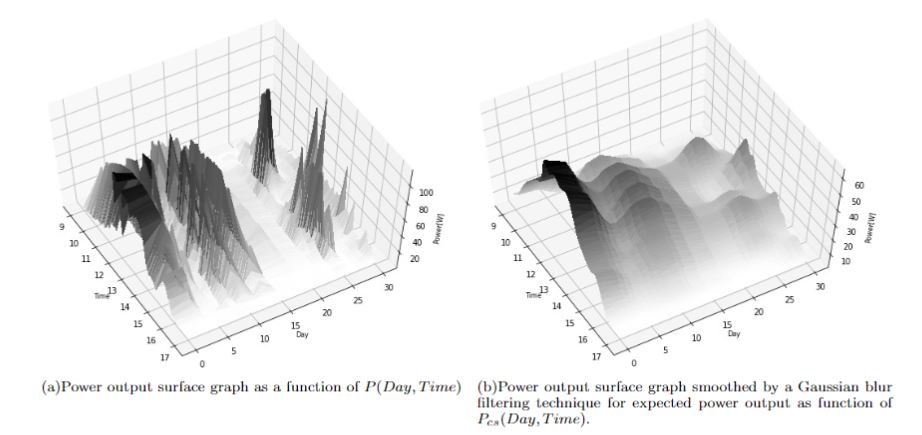Very Short-Term Photovoltaic Power Forecasting Using Stochastic Factors
Main Article Content
Abstract
This paper proposes a photovoltaic (PV) power forecasting model, using the application of a Gaussian blur algorithm filtering technique to estimate power output and the creation of a stochastic forecasting model. As a result, affected power can be forecasted from stochastic factors with machine learning and an artificial neural network. This model focuses on very short-term forecasting over a five minute period. As it uses only endogenous data, no exogenous data is needed.
To evaluate the model, results were compared to the persistence model, which has good short-term forecasting accuracy. This proposed PV forecasting model gained higher accuracy than the persistence model using stochastic factors.
Article Details

This work is licensed under a Creative Commons Attribution-NonCommercial-NoDerivatives 4.0 International License.
References
U. K. Das, K. S. Tey, M. Seyedmahmoudian, S. Mekhilef, M. Y. I. Idris, W. Van Deventer, B. Horan, and A. Stojcevski, “Forecasting of photovoltaic power generation and model optimization: A review,” Renewable and Sustainable Energy Reviews, vol. 81, pp. 912-928, 2018.
J. Antonanzas, N. Osorio, R. Escobar, R. Urraca, F. Martinez-de Pison, and F. Antonanzas Torres, “Review of photovoltaic power forecasting,” Solar Energy, vol. 136, pp. 78111, 2016.
S. Sobri, S. Koohi-Kamali, and N. A. Rahim, “Solar photovoltaic generation forecasting methods: A review,” Energy conversion and management, vol. 156, pp. 459497, 2018.
C. Puvareka and N. Kannan, “Fundamentals of Photovoltaic Technology (PV):A Review,” Middle-East Journal of Scientific Research, vol. 25, no. 3, pp. 536-542, 2017. [Online]. Available: https://www.idosi.org/ mejsr/mejsr25(3)17/15.pdf
A. Zervos. Renewables 2018 global status report. [Online]. Available: https://www.ren21. net/gsr-2018/
M. Rana, I. Koprinska, and V. G. Agelidis, “Forecasting solar power generated by grid connected pv systems using ensembles of neural networks,” in 2015 International Joint Conference on Neural Networks (IJCNN). IEEE, 2015, pp.1- 8.
H. Wang, H. Yi, J. Peng, G. Wang, Y. Liu, H. Jiang, and W. Liu, “Deterministic and probabilistic forecasting of photovoltaic power based on deep convolutional neural network,” Energy Conversion and Management, vol. 153, pp. 409- 422, 2017.
S. Leva, A. Dolara, F. Grimaccia, M. Mussetta, and E. Ogliari, “Analysis and validation of 24 hours ahead neural network forecasting of photovoltaic output power,” Mathematics and computers in simulation, vol. 131, pp. 88-100, 2017.
S. Pfenninger and I. Staffell, “Long-term patterns of european pv output using 30 years of validated hourly reanalysis and satellite data,” Energy, vol. 114, pp. 1251-1265, 2016.
D. P. Larson, L. Nonnenmacher, and C. F. Coimbra, “Day-ahead forecasting of solar power output from photovoltaic plants in the american southwest,” Renewable Energy, vol. 91, pp. 11- 20, 2016.
A. Tascikaraoglu, B. M. Sanandaji, G. Chicco, V. Cocina, F. Spertino, O. Erdinc, N. G. Paterakis, and J. P. Catalao, “A short-term spatiotemporal approach for photovoltaic power forecasting,” in 2016 Power Systems Computation Conference (PSCC). IEEE, 2016, pp. 1-7.
S. Dutta, Y. Li, A. Venkataraman, L. M. Costa, T. Jiang, R. Plana, P. Tordjman, F. H. Choo, C. F. Foo, and H. B. Puttgen, “Load and renewable energy forecasting for a microgrid using persis tence technique,” Energy Procedia, vol. 143, pp. 617-622, 2017.
S. I. Vagropoulos, G. Chouliaras, E. G. Kardakos, C. K. Simoglou, and A. G. Bakirtzis, “Comparison of sarimax, sarima, modified sarima and ann-based models for shortterm pv generation forecasting,” in 2016 IEEE International Energy Conference (ENERGYCON). IEEE, 2016, pp. 1-6.
H. Zhu, X. Li, Q. Sun, L. Nie, J. Yao, and G. Zhao, “A power prediction method for photovoltaic power plant based on wavelet decomposition and artificial neural networks,” Energies, vol. 9, no. 1, p. 11, 2016.
E. Ogliari, A. Dolara, G. Manzolini, and S. Leva, “Physical and hybrid methods comparison for the day ahead pv output power forecast,” Renewable energy, vol. 113, pp. 11-21, 2017.
M. Kudo, A. Takeuchi, Y. Nozaki, H. Endo, and J. Sumita, “Forecasting electric power generation in a photovoltaic power system for an energy network,” Electrical Engineering in Japan, vol. 167, no. 4, pp. 16-23, 2009.
B. Marion, A. Anderberg, C. Deline, J. delCueto,M. Muller, G. Perrin, J. Rodriguez, S. Rummel, T. J. Silverman, F. Vignola et al., “New data set for validating pv module performance models,” in 2014 IEEE 40th Photovoltaic Specialist Conference (PVSC). IEEE, 2014, pp.1362-1366.
M. Rana, I. Koprinska, and V. G. Agelidis, “Univariate and multivariate methods for very shortterm solar photovoltaic power forecasting,” Energy Conversion and Management, vol. 121, pp.380-390, 2016.
F. Wang, Z. Zhen, B. Wang, and Z. Mi, “Comparative study on knn and svm based weather classification models for day ahead short term solar pv power forecasting,” Applied Sciences, vol. 8, no. 1, p. 28, 2018.
C. Voyant, G. Notton, S. Kalogirou, M.-L. Nivet,C. Paoli, F. Motte, and A. Fouilloy, “Machine learning methods for solar radiation forecasting: A review,” Renewable Energy, vol. 105, pp. 569- 582, 2017.
H. T. Pedro and C. F. Coimbra, “Assessment of forecasting techniques for solar power production with no exogenous inputs,” Solar Energy, vol. 86, no. 7, pp. 2017-2028, 2012.
R. Mueller, K.-F. Dagestad, P. Ineichen, M. Schroedter-Homscheidt, S. Cros, D. Du-mortier,R. Kuhlemann, J. Olseth, G. Pier-navieja, C. Reise et al., “Rethinking satellite-based solar irradiance modelling: The solis clear-sky module,” Remote sensing of Environment, vol. 91, no. 2, pp. 160-174, 2004.
C. Rigollier, O. Bauer, and L. Wald, “On the clear sky model of the esra–european solar radiation atlas–with respect to the heliosat method,” Solar energy, vol. 68, no. 1, pp.33-48, 2000.
J. Zhang, A. Florita, B.-M. Hodge, S. Lu,H. F.Hamann, V. Banunarayanan, and A. M. Brock-way, “A suite of metrics for assessing the performance of solar power forecasting,” Solar Energy, vol. 111, pp.157-175, 2015.


